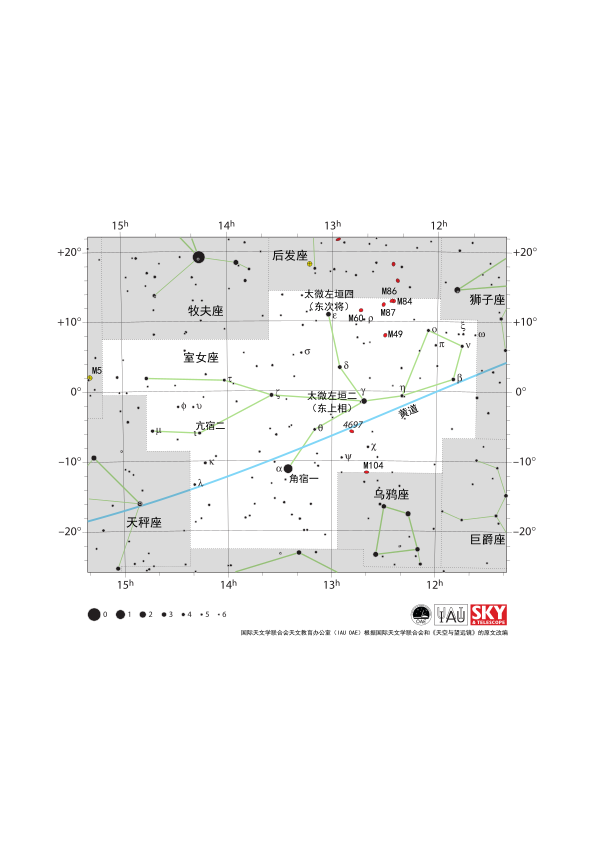This page describes an image 室女座星图
Download PDF File (PDF file 177.00 kB)
Diagram caption:
黄道星座室女座与周边星座示意图。从顶部开始沿顺时针方向,室女座周边的星座依次为:后发座、狮子座、巨爵座、乌鸦座、天秤座和牧夫座。室女座最亮的恒星是角宿一,位于该图中央、黄道下方。可用如下的”春季大弧线“在夜空中定位角宿一:顺着北斗七星的斗柄出发,延伸至牧夫座的大角星,再沿直线向下寻找,就可以找到角宿一。可用口诀来记忆:“顺着斗柄至大角,直下寻得角宿一。”角宿一的位置略低于黄道——从地球看来,太阳以一年为周期在天球上移动,所经过的路径称为黄道,在图中以蓝色实线标注。太阳在每年九月中旬到十月下旬位于室女座。太阳系中的其他行星也经常出现在室女座。
室女座横跨天赤道,因此在地球上的任何地方,一年中的某些时候都能看到其部分天区。但在地球南北两极,室女座的部分天区会被遮蔽。室女座在北半球的春季和南半球的秋季夜晚最适宜观测。
室女座常被描绘为背靠黄道平躺的少女形象,双臂向两侧舒展,双足则指向东方。室女座内可见多个深空天体,包括NGC 4697、M49、M87、M86、M84和M60,在图中均以红色椭圆标注。这些天体都是旋涡星系与椭圆星系,距离地球数百万光年,均属于离银河系最近的星系团——室女座星系团。其中M87星系尤为值得注意,其核心的超大质量黑洞于2019年被事件视界望远镜成功拍摄,这是人类拍摄到的首张黑洞照片。这个黑洞被命名为Pōwehi,在夏威夷语中意为”无限创造的黑暗源泉“。
该图的纵轴为赤纬,横轴为赤经,方向为上北下南左东右西。图中标注的恒星大小对应其视星等——衡量天体视亮度的标准,较大的圆点代表着较亮的恒星。图中的希腊字母标注着星座中最亮的恒星。这些恒星按亮度排序,最亮的一般被标记为α星,第二亮的一般为β星,等等,不过这种字母排序并不总是和实际亮度排序完全一致。图中虚线标注的是国际天文学联合会划定的星座边界,绿色实线则是一种常见的星座形象连线。需要注意的是,在实际观测时,这些边界与连线都不会出现在天空中。
Diagram credit: 国际天文学联合会天文教育办公室(IAU OAE)根据国际天文学联合会和《天空与望远镜》的原文改编. Credit Link
Diagram translation status: Not yet approved by a reviewer
Diagram translators: Bao Lizhuo
Related glossary terms:
北斗七星
, 天球坐标
, 天秤座
, 室女座
, 星座
, 星系团
, 椭圆星系
, 漩涡星系
, 狮子座
, 视星等
, 赤纬
, 赤经(RA)
, 超大质量黑洞
, 黄道
, 黄道十二宫
Categories:
Naked Eye Astronomy
Diagram license: Creative Commons 署名 4.0 国际 (CC BY 4.0) Creative Commons 署名 4.0 国际 (CC BY 4.0) icons
In Other Languages
英语: Virgo Constellation Map意大利语: Mappa della Costellazione della Vergine
西班牙语: Mapa de la constelación de Virgo
繁体中文: 室女座星圖
The diagram captions presented on the OAE website were written, translated and reviewed by a collective effort from the OAE, the OAE Centers and Nodes, the OAE National Astronomy Education Coordinators (NAECs) and other volunteers. You can find a full list of credits for our translation project here. All media file captions are released under a Creative Commons CC BY-4.0 license and should be credited to "IAU OAE". The media files themselves may have different licenses (see above) and should be credited as listed above under "credit".
If you notice a error in this diagram or its caption then please get in touch.









